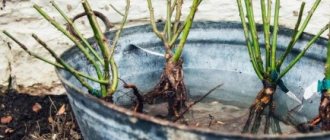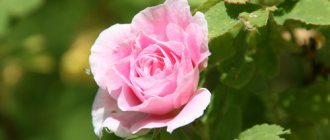Rose “Aqua” is another attempt by breeders to get closer to creating “blue” roses. Its forms are perfect, and its color is unique and changeable: from cold pink as it blooms, it becomes lilac, and in fully opened flowers it fades to a delicate pale blue hue.
Rose "Aqua" (pictured) is a commercial variety that has earned great popularity among amateur gardeners
Description of the species
The “aqua” rose variety was bred in Holland and belongs to the Rosaceae family, a variety of hybrid tea roses. The flower has a pure pink color. It is distinguished by a large number of shades - from pale pink to rich lilac-pink. Flowering is observed from the first month of summer until frost.
The buds are quite large, 8-12 cm, double, with dense petals, located on long stems, and have a very pleasant, memorable smell. This variety is characterized by the coloring of the petals from lighter at the base to darker at the edges. Interestingly, the color of the flower changes as the flowering stages progress. Gradually it fades from sunlight and the color becomes pale blue.
This variety tolerates frosts down to -10 ºС and is relatively resistant to diseases and pests. For the winter it must be protected from the cold.
Characteristics
- According to reviews, an Aqua bush planted in the fall will bloom the next year, but do not rush to load it, it is best to save the young plant until next year, when it, having become stronger, will show real possibilities;
- The frost resistance of the rose corresponds to USDA zone 6 (according to the classification of the US Department of Agriculture), that is, the bush is able to overwinter at -23.3°C. Numerous reviews confirm good resistance to the declared temperature. But there are also opposite reviews, complaining about freezing of the bush even in warm regions;
- immunity is rather average. If the resistance to powdery mildew is generally not bad, then numerous complaints about black spotting indicate Aqua’s poor resistance to this disease;
- The flowers' resistance to humidity is low. There is information that even short-term exposure to rain leaves stains on the petals, and unopened buds can even rot;
- Aqua tolerates heat with temperatures rising to 40 °C, which has often happened in the south in recent years, just as poorly. In such conditions, flowering is sparse, the plant develops at a slow pace;
- the most suitable conditions for our heroine to show the best results are warm (but not hot) and dry weather, with a temperature of about 25 °C;
- Color fastness to intense light is low; in bright sun the color fades. Therefore, in the southern regions it is better to plant roses in areas protected by diffuse partial shade during the midday period. But the capricious flower also cannot tolerate dense shadow. Those who grow Aqua for cutting use one trick to preserve the rich color of the buds. Rose growers put bags of thick paper on the flowers that have not yet bloomed, allowing them to preserve the juicy pink color until the moment of cutting. This trick is also suitable for an ordinary gardener, especially during the rainy season;
- the aroma is weak, but very delicate, memorable - fresh, with subtle notes of lemon balm, pear and vanilla;
- A cut rose can remain attractive in a vase for more than 10 days.
Features of hybrid tea varieties of roses
In their homeland, hybrid tea roses are called large-flowered. They have become a real event in the floriculture world due to their qualities and beauty. Over the 100-year history of existence and breeding, such varieties have become very popular and widespread among amateurs and professionals.
The main advantage of hybrid tea varieties is long and continuous flowering throughout the warm season, and in the greenhouse even in the colder months. In total, there are about 100 such varieties in the world, with a wide variety of colors: from white and yellow to pink and burgundy.
The hybrid tea rose “aqua” is one of the most beautiful representatives of this species. It grows on a bush up to 0.8-1.2 m high, which has strong, even stems that are almost devoid of thorns.
History of selection
The authorship of the variety belongs to the breeders of the Dutch company Schreurs (Petrus Nicolaas Johannes). Planting material is supplied to the retail chain under the patented name Aqua!®, which is a trademark. In catalogs the rose appears under the code SCHrenat. At the Flowers Expo exhibition in Moscow, the variety was awarded the Syracuse Rose Society award in the Show category.
Planting and care
Caring for rose bushes will not be difficult even for amateurs and novice gardeners. Those of them who have been involved in growing the “aqua” rose variety always give positive reviews, full of delight at the beauty and smell of this delicate flower.
The first year after planting is of great importance, when growth, development, establishment and flowering occur. Rose bushes are planted either in autumn (no later than a month before frost) or in April-May. To do this, select a sunny or partial shade place, preferably protected from the wind, for example, under the cover of a wall on the north side.
For a seedling 30 cm high, you need to dig a hole up to 0.4 m deep and put drainage at the bottom. The bush should be planted in a mixture of soil and humus, and also add fertilizer. The distance between crops can be about 0.5 m. The rose bush is planted in the spring so that the grafting site is 3 cm lower than the soil surface.
This variety is grown both in open ground and in greenhouses. The basic rules for caring for the “aqua” rose variety include regular watering, fertilizing, removing weeds, and ensuring disease prevention.
Reproduction methods
The Aqua rose variety is best propagated by autumn cuttings, when cuttings from semi-lignified shoots with 4 buds are buried in a prepared trench at an angle. The plantings are covered with bottles, under which they overwinter. In spring, established plants are taken care of as usual.
Plant nutrition
As a top dressing, slurry is most often used, which contains the necessary chemical elements, as well as beneficial bacteria. It is the latter that convert compounds inaccessible to plants into a form that is perfectly absorbed by them.
Feeding is done once every 2 weeks, and during the summer season only 3-4 times (from the end of June to August). Mullein must first be prepared, for which it is placed in a barrel with water in a ratio of 1:3 1.5-2 weeks before use. Chemical fertilizers are also added to this mixture: potassium sulfate and double superphosphate (calculated at 15 g per 10 liters of water).
The finished infused concentrate is diluted with water in a ratio of 1:10. Furrows are made around the bush at a distance of 35-40 cm, into which water is first poured, and then the resulting composition with mullein is poured. 3-5 liters are added to each bush, then the furrows are filled with soil or sand, the next day the soil should be loosened.
Also in the spring, complex mineral fertilizer is applied along with ammonium nitrate, and in the autumn, fertilizing with potassium and phosphorus is done.
Agricultural technology
The first thing you should pay attention to when growing an ornamental hybrid of Dutch selection is the planting material. It is better to purchase seedlings from specialized certified nurseries. Only in this case can we speak with confidence about the preservation of varietal qualities
Only in this case can we speak with confidence about the preservation of varietal qualities.
When choosing an Aqua rose seedling, pay attention to the following points:
- It is better to choose a seedling with a strong root system, such a plant will take root easier, will be less sick, and will form buds faster;
- there should be no rot, mold or mechanical damage on the roots and shoots;
- try to plant a young bush in a permanent place in early spring, before active growth begins.
It is advisable to select a place for planting hybrid tea Aqua that is sunny or partially shaded. Strong gusts of wind can lay or bend the stems. Therefore, to preserve their decorative qualities, bushes of this variety should be planted away from windy areas. The ideal location would be a rose garden, closed on the north side by a building or dense hedge.
The soil for Aqua roses should be fertile and well-drained. The bush should be planted in holes with previously prepared soil mixture.
To plant one bush you will need:
| 1 part | humus or peat |
| 2 parts | fertile soil layer |
| 2 parts | sand or gravel (if planting is done on sandy soil, this component does not need to be added) |
As fertilizers, you can use superphosphate, which is distributed at the rate of 100 g per 1 m², ammonium nitrate - 25 g per 1 m². You can also use 10 g of potassium chloride and a small amount of lime.
Fertilizers should be selected based on the individual characteristics and composition of the soil.
The holes are made with an interval of 50 cm, this will make it easy to form bushes and provide an unobstructed approach to the plant. Before planting, the hole must be watered and the roots dipped in wood ash (ash disinfects the root system and prevents the development of microbial diseases). The bush is pressed tightly to the ground, covered with the prepared mixture, pressed down again, and watered again.
The grower must determine the depth of the hole himself. It will directly depend on the size of the root system. You need to ensure that drainage with a mixture of fertile soil and humus fits into the hole. I lay the roots without bends, and the root collar is buried no more than 5 cm.
Watering and flowering
Rose "aqua" needs frequent regular watering, 3-4 times a week is enough. In this case, it is necessary to ensure that the soil does not become waterlogged and water does not fall on the leaves. The best time for watering is early in the morning, after which the soil should be well loosened to a depth of 4-5 cm. This will provide air access to the roots. After watering, it is necessary to mulch to avoid overheating.
Excessive flowering in the first year of the plant’s life is not recommended, as this will result in the formation of too large a root system. Small buds that appear in the first half of summer should be removed immediately. In August, you can leave 1-2 flowers, which will allow the plant to prepare for the cold weather.
Interesting video
We invite you to watch a video review of the Aqua rose variety:
The hybrid tea rose Aqua, which will be discussed in today's article, is an amazingly beautiful plant. The variety, created by Dutch breeders, has gained wide popularity among us.
Rose Aqua is a perennial plant, the result of crossing a tea rose and a remontant rose. It is a shrub, reaching a height of 80–100 cm and a width of 50–60 cm. The stems are practically devoid of thorns. They are smooth, durable, and quite long. Leaves are rich green.
The color of the buds can be lilac, bright pink, purple, depending on the location of cultivation. And if you are lucky and the season is not rainy, then the Blue Rose will awaken, which retains this heavenly color for several days. The shape of the flower is similar to a wine glass with a high central part. Large silky flowers up to 12 cm in diameter grow on tall peduncles. The petals of the Aqua rose are dense, there are about fifty in one bud; at the base they are lighter than at the edges. This makes the flower look even more voluminous. The veins are expressive in relief and lightly gilded in color. During flowering, the buds change their color - this is a feature of this variety, while the color of the stem leaves remains the same.
The Aqua rose begins to bloom at the end of June and continues to delight the eye with its beauty until moderate frosts down to -10ºС. The pronounced fragrance of the flowers cannot be confused with any of the other varieties of roses. The shrub perfectly resists diseases and pests.
Possessing the characteristics described above, the Aqua rose is a cut variety of roses that is planted in greenhouses, greenhouses and open ground.
Shelter for winter and spring work
In autumn, when the temperature begins to drop below zero, young rose bushes must be covered. Otherwise, they will freeze and may die. For protection, dry soil or sand is used, which is used to hill up the bush to a height of 30 cm, and spruce branches are also placed on top.
In the spring, as soon as fresh shoots begin to appear, all shelters are removed in stages, 8-10 times. It is best to do this in cloudy weather or in the evening so that the sun's rays do not damage the shoots. After removing the last layer, it is recommended to cover the young branches again with spruce branches from the sun.
Immediately after removing the covering layer and freeing the branches, the bush should be pruned.
Diseases and pests
When growing aqua roses, like all representatives of hybrid tea varieties, gardeners most often encounter fungal diseases. Their causative agents are parasitic fungi that feed on the substances that the bush receives. They spread due to high humidity and heat. Nitrogenous fertilizers often promote their development. They reproduce very quickly by airborne spores.
Common diseases:
- Rust. Usually moves to rose bushes from a nearby juniper tree. To avoid infection, bushes should not be planted nearby.
- Powdery mildew (downy mildew). Often found in rainy summers, it appears as red or brown mold. To prevent this disease, bushes need to be planted in places where air circulates well. Affected leaves should be destroyed immediately. Along with powdery mildew, aphids often coexist. To combat it, plants are sprayed with a solution of alcohol and laundry soap.
- Gray rot. Affecting leaves and flowers, it forms a gray coating. Decaying parts of the plant turn black and die. To combat it, the bushes are sprayed with horsetail decoction. All diseased parts should be removed.
Pests of pink aqua rose bushes are caterpillars and larvae that actively eat leaves, shoots and roots:
- Leaf roller. It eats all the green parts of the plant and entangles it in cobwebs. All affected parts must be removed, and the bushes are treated with insecticides.
- Moths. These green caterpillars love to eat shoots and leaves. After their detection, the plant must be treated.
- Spider mites. They settle on the plant, sucking its juices. After this, the bush turns yellow and dies. Spider mites often appear during dry periods.
- Nematodes. Worms live on the roots of the rose bush. They can only be destroyed together with the diseased plant. Then calendula or other flowers are planted in this place, which repel nematodes.
The subtleties of growing a flower
The hybrid tea rose variety is grown by planting seedlings in open ground. After purchasing seedlings, you must immediately start planting them. First straighten them, trim the ends of the branches. Do not add fertilizer to the dug hole; this will be done later.
Landing dates
It is advisable to plant bushes in the fall, from September to October. With proper planting and reliable shelter, the growth process will accelerate. In the spring, the “protection” is removed, young seedlings will grow abundantly.
Choosing healthy seedlings when purchasing
It is better to buy material from trusted sellers, on the market or in specialized stores. The flower is sold in the form of seedlings, the roots are placed in peat cups.
See also
Description and characteristics of Aloha roses, planting and care rules, applicationRead
What to look for when purchasing:
- appearance of the shoots - they should be undamaged, light green, moist;
- Leaves normally have a leathery surface, a rich green color, or may have a brownish tint.
You cannot store cuttings in a peat mixture for longer than 3 weeks.
Selection and preparation of a site
Roses should be planted in a place where there is enough sunlight, but not all the time. It is advisable not to use the southern side so that the buds do not burn out and flowering is prolonged. There shouldn’t be a lot of shade either, since the place may be damp, which will cause the roots to rot and diseases to arise.
You should not plant the plant where tall trees grow, as their roots and shady crowns will quickly suppress the growth of the bush. The best place to land is where there is shade at midday. The soil should be neutral; if the site is loamy, add manure and sand. Fresh compost is not recommended, as its substances can have a negative effect on the sensitive root system.
Landing technology
The planting process is carried out in stages.
- Place the seedlings in the center of the hole, carefully straightening the root system.
- Cover the roots with soil, placing their neck 5 centimeters higher from the ground.
To achieve good bush formation, plant the planting material at a distance of 1 meter from other plants. The higher the neighbor in the garden, the larger the gap should be.
Plant seedlings from each other with a distance of 80 cm, between rows - 2 meters.
Roses and perfumes
Charming pink aromas of love have been used to create perfumes since ancient times. Nowadays, several hundred varieties of roses are successfully used to create perfumes or eau de toilette. They are used to make oil, water, or a solid extract called “rose concrete.”
The recognized capital of perfume is Paris. France has been cultivating rose plantations specifically for the creation of such products for several centuries.
“Aqua Allegory Rose” is one of the fragrances in the Guerlain line, which was first introduced to the public back in 1999. When creating this perfume series, its founder, Jean Paul Guerlain, dreamed of expressing his passionate love for natural garden scents.
“Aqua Allegory Flora Rose” is one of the bright floral fragrances from the Guerlain series. It was released in 2013 and combined the scents of roses, red berries, iris and musk.
Many women love very feminine and delicate flower scents. Therefore, these notes are present in almost every perfume product.
Application in landscape design
Abundantly flowering rose bushes are widely used to decorate various garden areas:
- near the gazebo;
- to decorate the front of the house and the central entrance;
- as a tapeworm against the background of a smooth green lawn;
- for creating flowering compositions in combination with other shrubs.
Rose Aqua is a stable and hardy flower with an exquisite aroma and the absence of thorns. And if you follow simple rules, growing the queen of flowers will not cause any difficulties.











